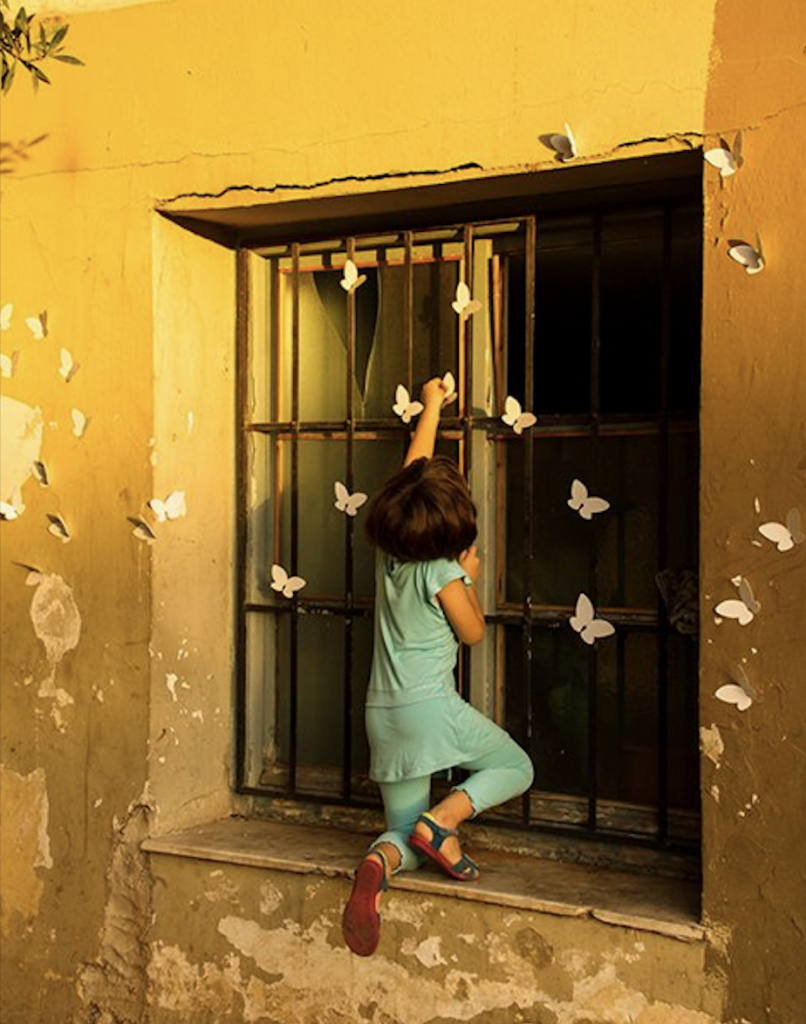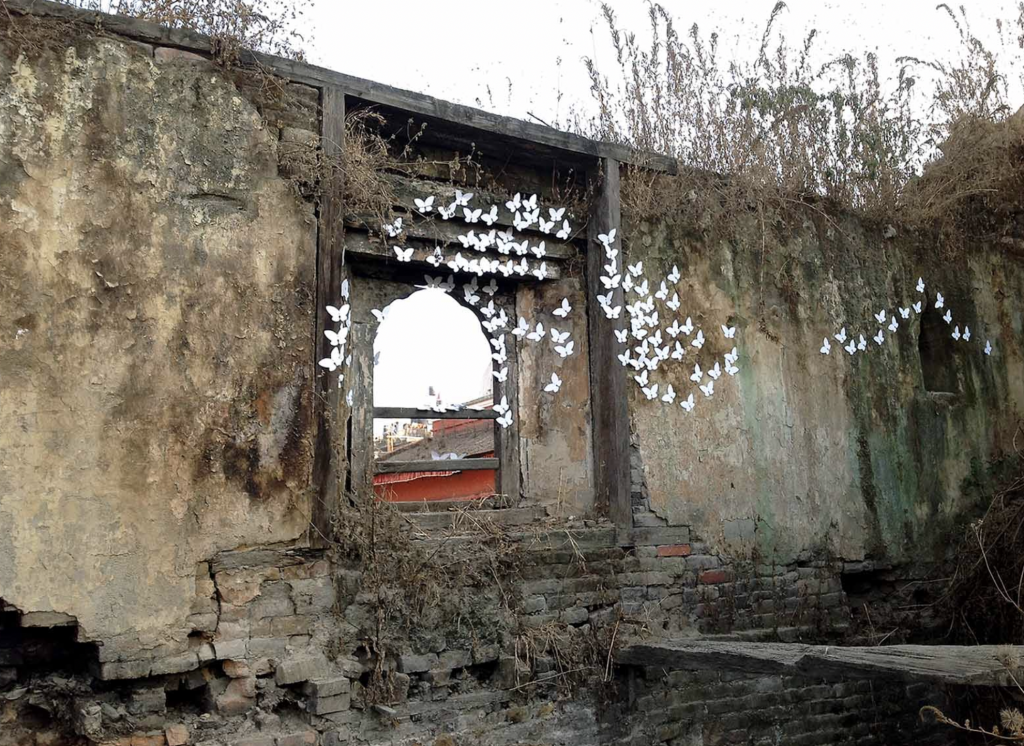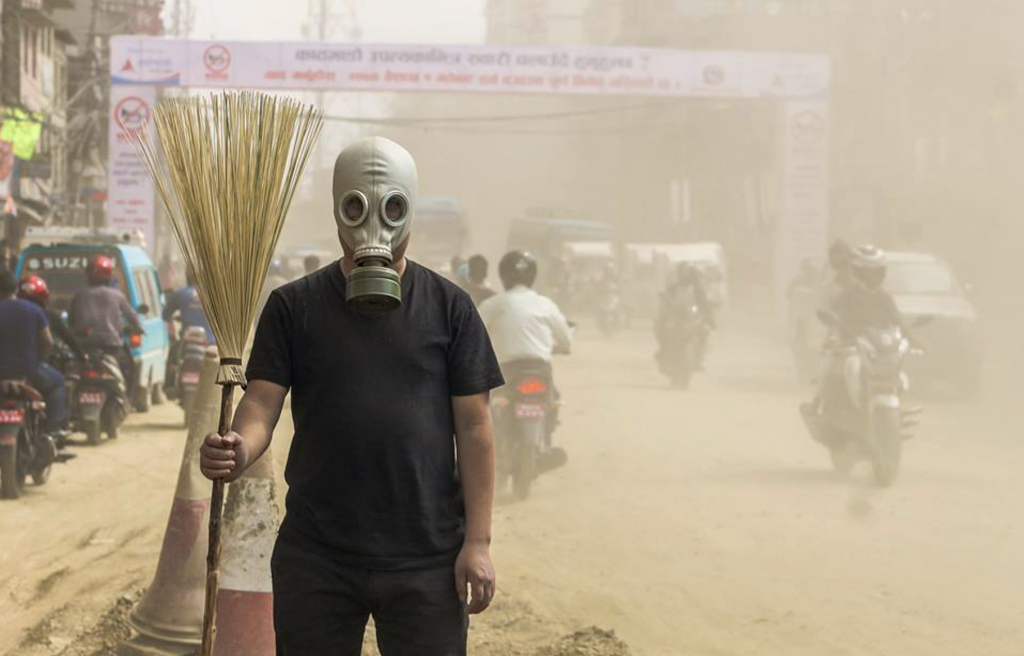Artist Interview with Milan Rai
The biennial Social Art Award by the Institute for Art and Innovation honors artists and art initiatives aiming to generate social impact. By encouraging public participation, art can fuel transformation in society. This year, issues of biodiversity, resource saving and environmental shaped the call for Social Art Award projects. The New Greening-theme inspired more than 700 artists to apply and enabled the public to imagine more sustainable and green futures together.
In particular, Milan Rai’s projects guide social and environmental change and was therefore handed over the the Honorable Mention for the most local impact.
Milan is a conceptual artist working across situations, interventions and eco-social art practices in Nepal. With his focus on rewilding the city, ecological ethics, and socio-ecological resilience, he aims to affect decision-making. In his art project entitled White Butterflies, the artist took over a public space by covering 1200 trees that were marked to be cut in Kathmandu, Nepal’s capital city. The project connects like-minded people, which in turn formed a local community sharing the goal of saving trees. Milan’s art intervention White Butterflies and his organization of a protest resulted in the preservation of 25% of the trees that were planned to be cut. White Butterflies is a project the artist has started in 2012. Yet, Milan Rai seeks to intervene public spaces with his eco-social art practices in every single project. In this interview, he provides insight into his objectives and how he seeks to achieve them through his art.
Art to provoke discussion on New Greening
What does the New Greening Project mean to you and where does your artwork fit into the conversation? What do you think is the role of art in sustainable transformation?
“While reckless urbanization has overstressed and reduced the open spaces, the New Greening requires a nature-based innovation. My practice broadly engages with conceptual thinking and arts-based methodology to spur dialogue in government and across communities to impact policies, disciplines, hearts, and minds to work jointly and urgently to build socio-ecological resilience and sustainable transformation.
For the project ‘White Butterflies,’ I went around the city spreading these Butterfly installations in various public spaces. However, to tangibly transform urban spaces, I paced the Butterfly installation around government offices and concerned departments wearing a gas mask to draw attention to issues I wished to tackle. Through consistent effort and action in place, I was able to establish connections with the local authorities build trust and cooperation, which germinated the idea of creating green spaces within urban cores. For a public project, like this, the materials are time, attitudes, political conditions, disappointments, and differences to overcome. To balance the dynamics of public space, negotiating differences among these actors in a complex cross-sectoral structure and harmonizing links between disciplines to find solution is art.“

Local art for local problems
Can you talk about the collaborative aspect of your art? What were your inspirations and how does community influence the perspective of your piece?
“I take a transdisciplinary approach conjoining local experiences, global knowledge-base, and insights to address the most pressing needs. My earlier project ‘White Butterflies’ which started as a personal response to the world around me grew into advocacy and imaginative approach to rethink public spaces. This evolution around my art laid the groundwork for my eco-social art practice. I link ideas from relational aesthetics, new materialism, and creative resistance to produce counter normative insights.
The neighborhood quality influences my work varying upon the place, context, and community conditions. Some disordered localities with unresolved issues and hangovers of the past have an overarching effect on social perceptions and behavioral dimensions. The mundane frustrations reflect on their choices, reasoning, and decision-making. The partial and inequitable engagement recede the community bonding. They seemingly don’t realize the collective effort and liaise with the meaningful work to be realized over time.
Fostering social coherence amongst urban dwellers in a commercially concentrated area is even tougher. The market forces and psychological effects of living in this commercial area undermine the possible rewards of society’s wellbeing. Relatively it’s easier to work in residential areas that are likely to understand and be supportive once the trust and relationship are built. But you don’t achieve everything at once, it is always a work in progress.”
Tackling “Pretty Politics”
Did/ Do you face any limitations/shortcomings when turning the vision of your work into reality? If so, could you explain it?
“We should be transcending the barriers. Yet, sadly, we are repeating the same old mistakes. I urge them to upgrade the standard to re-invent public spaces. However, the political instability and the monopolies abandon the conception, planning, and flow of new ideas.
The city administrators aren’t able to comprehend and manage the diverse expertise and dynamics of place-making. There are disincentives to develop explicit design guidelines and frameworks. Our public impact projects are tendered, outsourced, and assigned to consultancies acquired through favouritism and prevailing kickbacks. The city authorities modify the designs without thoughtful deliberations, accountability, transparency, and morality.
I often feel conflicted between vested interest, short term thinking, petty politics, bureaucratic hassles, and malpractice by public officials, contractors, and committee members. My ideas are excluded in favour of expensive contracts that are only one facet of corruption. Numerous consultancies with awful records blow-outs the cost by overloading the materials. This negligence comes at a significant cost to taxpayers. Non-financial costs include the loss of intangible heritage and social prosperity.
I intervene with preventive countermeasures to curb the side effects and propose alternatives to status quo/social deadlocks. At the meso-level, I pursue empathetic pathways to cultivate community spirit and reactivate public spaces in every sense.”

The Transformation of urban spaces
To what extent do you see your work bringing different meanings to the New Greening vision? What type of conversation does it introduce with respect to our future goals as a society and regarding sustainable transformation?
“The green activities in our current infrastructure are trending in the wrong direction. In contrast to patches and manicured lawns, my work incites on rewilding the city. The project links the fragmented and potentially biodiverse sites, to create a network of regenerative green spaces to restore soils, habitats and support a more diverse entomological ecosystem.
I am synthesizing various disciplines, field works, and speculative designs to explore the socio-ecological complexities. I shall translate scientific inquiries into tangible, multisensory experiences like film, podcasts, songs, poetry, installations. This perspective reaches out to the general public through various mediums and technology. I am working on a children’s book, that tells stories about the creation of green spaces and the impact of urbanization upon the landscape. It shows the world around us through magical realism and mythopoetic. This is a story about ourselves infused with modern mythology.
My work pays attention to the more-than-human world within the matrix of connectivity and interdependence of all life. I see the city as a living laboratory for the applied research and theories to analyze history and current issues. With direct observation, reflection, and psychological intervention, I push the boundaries for a better prototype for the future, a gateway to eco-conscious societies in the age of Anthropocene.”

Extending the boundaries
What do you wish to let the viewer know about your work that might not come out explicitly? What do you hope to inspire with your artwork?
“Initially, I started as a painter so a lot of people ask ‘why did you stop doing art?’ Then I state that I am painting effusively in immersive landscapes instead of canvases. So, the parks I am creating now are my paintings where people can walk, stroll, wander lost, sit, meet, greet. Some of the edible landscapes include herbs, edible flowers, and fruits which is a progressive approach to conventional green infrastructure in cities. While the gallery keeps the “Do not touch” sign in most artworks, this land art allows you to pluck the fruits. It means you can even taste the painting. It shifts the general perception of art and invites all sensory expressions beyond the visual parameters.
Who owns the art afterward? – It surpasses the idea of authority that controls, the exhibition space, art production, and its relation to people’s lives. I am giving up control over the artwork where the naturally occurring phenomena like seasons, acoustic, light, and winds educes a natural choreography. This ecological motion entails the trees, flowers, bees, birds, butterflies, worms, and microorganisms. These breathing spaces in a densely built environment nod contemplation and speculates about what art needs to do today and what it could become next in connecting people to nature-based practices and climate realities. It calls us to reflect on the collective vulnerability and reset ourselves to evolve and adapt to the looming global environmental crisis.

When art and activism meet
In the preservation and re-generation of green spaces, art can take on a lot of different function. In his art interventions, Milan Rai aims to challenge and redraw the boundaries of art conventions. By integrating art in public space, daily life and protest, the artist raises voices for the unheard and builds communities to fight environmental inequality. In doing so, art and activism become intertwined and share a common goal: ensuring transformation! Milan Rai’s White Butterfly demonstrates that art goes beyond raising awareness. It shows that art, by making it social, can influence and transform policy.
Read more about Milan Rai’s projects here: https://milanrai.art/movement/
– Interview by Antje Jacobs
